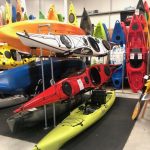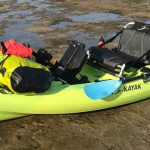Touring kayaks are fast, sleek, and comfortable. In this guide, we’re going to review the best touring kayaks.
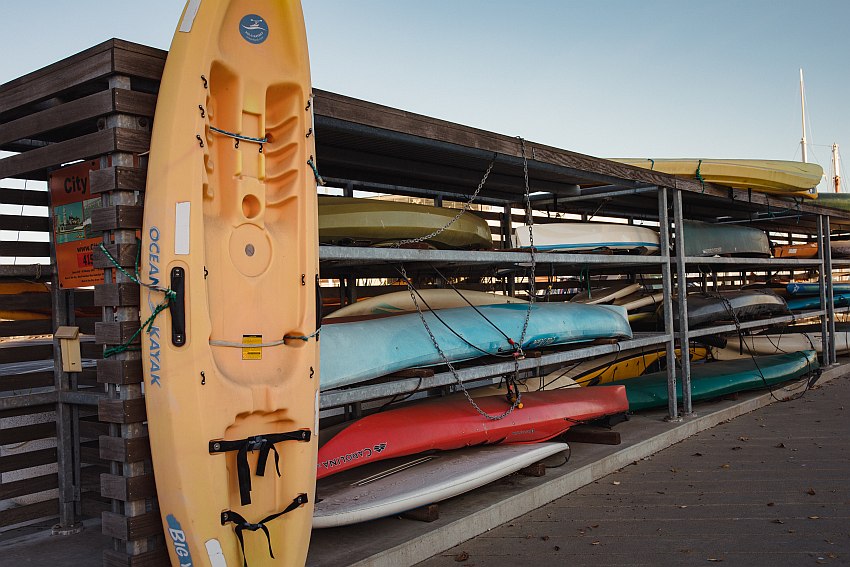
Buying a brand-new kayak isn’t always the smart way to go.
Sure, a new kayak will be pristine, free of dents and dings, and ready to embark on her maiden voyage with you as the captain. Going the route of brand-new gives you the chance to choose the exact kayak that suits your needs and guarantees you get what you pay for.
But there are many times (as you’ll see below) that it’s just smarter to go with a pre-owned or used kayak.
Buying used kayaks doesn’t have to be a headache. In fact, it can actually be surprisingly easy!
Below, I’ll walk you through the process of buying a used kayak, looking at some of the reasons to go used rather than new, the most important factors to consider, the right time of year to buy a kayak, even where to look and how much to expect to pay.
By the end of this post, you’ll be ready to go kayak-shopping and a great deal on a used kayak.
10 Smart Reasons to Buy a Used Kayak
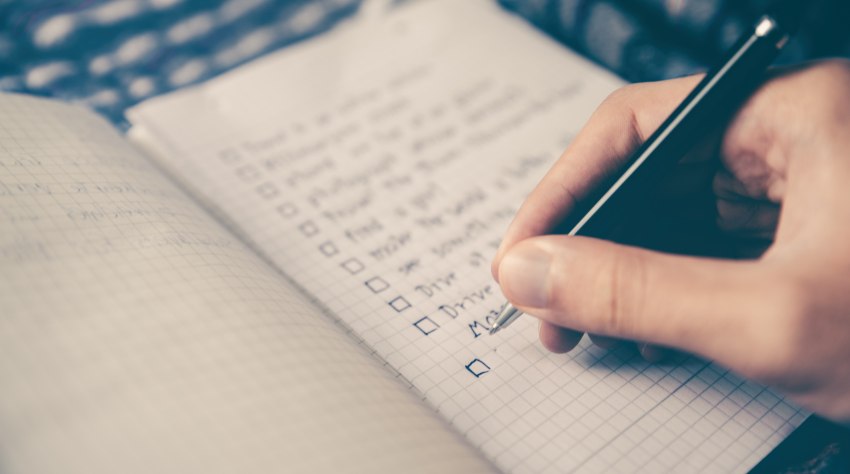
- You’re brand-new to kayaking. If you’re heading out on your first kayaking trip and you’re not yet ready to pay full price for a new kayak, you can pick up a used one as a “test kayak” to get a feel for it.
- You need a “beater”. A used kayak makes for a great “beater”, a kayak you can use without worrying (too much) about it getting damaged. This is great if you’re trying out whitewater kayaking, river kayaking, or any type of kayaking where there will be obstacles for the first time.
- You’re not sure you want to make kayaking your “thing”. Let’s be honest: kayaking isn’t for everyone. Some people prefer paddleboarding, canoeing, boating, or other water sports—and that’s perfectly okay. If you’re not yet 100% sold on kayaking as an activity you intend to pursue full-on, it’s a good idea to test the waters using a cheaper used kayak.
- Save money. This is probably the #1 reason most people end up buying used kayaks. Typically, you’ll pay significantly less for a used kayak than you would brand new (see the section “How Much Should I Pay for a Used Kayak?” below for more details). It’s an easier, cheaper way to get into kayaking at a lower cost of admission.
- You prefer an older, no-longer-available model. I’m not going to lie: I love my Azul Riot kayak, and it has performed better than most of the more modern kayaks I’ve tested. Sadly, the model is no longer available, so if I ever wanted to replace it, I’d have to buy used.
- You want it today. When you order a kayak brand-new (especially online), you don’t always walk out of the store with the kayak loaded on your vehicle and ready to paddle. You may have to wait a few days, weeks, or even months for delivery, based on availability of the product. But that’s never the case with a used kayak!
- You have kids. Kids love adventure, but they don’t often think too hard about caring for the adventure equipment they’re using. A used kayak (a “beater”) is a great thing to have if you want to bring your kids paddling with you but don’t want to spring for a brand-new kayak.
- Test out a product. Maybe there’s a kayak you’ve been considering, but you’re not sure it’s worth springing for a brand-new one. Buying it used gives you a chance to test it out for a few weeks or months (or even a whole season), so you can be 100% sure it’s a kayak that handles well and delivers what you need.
- Get a pre-tested product. This is a great idea especially for beginners who don’t know much about kayaking. Buying a used kayak that a more experienced paddler has tested and knows is reliable and sturdy can be the smart play, rather than trusting the salesperson at the sporting goods store actually knows what they’re talking about.
- Try a new style of kayaking. Maybe you’ve already got a lovely touring kayak but want to try your hand at whitewater kayaking, kayak racing, or kayak fishing. Rather than buying another brand new kayak or risking your existing kayak in an activity it’s not built for, you can opt for a used kayak of that specific style (fishing, whitewater, sea touring, racing, etc.) to get you started.
All pretty darned good reasons to consider buying used, right?
Factors to Consider
If you’re going to buy a used kayak, it’s important that you consider all the most relevant and important factors.
As you search online and in stores for used kayaks, ask yourself the following questions:
Does it suit my needs?
This is the most important question, and for obvious reason! You wouldn’t buy a fishing kayak to take on a sea touring trip, just like you wouldn’t take a racing kayak on your next kayak hunting trip.
You’ve got to find the kayak that suits your specific needs. That means:
- It has the right weight capacity and storage space to handle your weight and the requisite gear.
- It’s sized right to be comfortable for your specific body size (i.e., long legs like mine).
- It’s built for the specific activity you intend to enjoy.
You can find our complete Kayak Buying Guide right here, and use it to help you find the used kayak that suits your needs best.
Is it in good shape?
Remember, kayaks are typically made from ABS plastic, polyethylene plastic, fiberglass, or composites. The more advanced the material, the pricier the kayak. However, some materials are prone to being damaged—for example, fiberglass scratches more easily when impacting rocks and underwater obstacles.
It’s important that you take the time to look the kayak over thoroughly before buying it. Look for any signs of damage from impacts, mold/mildew, rough handling, or incorrect storage (see below). If the kayak isn’t in good condition, walk away. You might end up spending a lot of money to repair a defective or damaged kayak—and in the end, pay more for the used kayak than a brand new one.
How old is it?
Older kayaks aren’t necessarily worse. They’re merely old. And, in some cases, outdated.
Every time a kayak manufacturer releases a new model, those new models feature upgrades on the previous models. For example, lighter or sturdier materials, a re-designed seat, altered cockpit dimensions, gear expansion options, and the list goes on. Older-model kayaks may not be quite as “cutting-edge” as the newer models.
The age of a kayak is a factor to consider, but like with any vessel or vehicle, age isn’t the only factor. A 10-year old kayak that has spent just one season on the water then the rest of its life stored properly may be a far better investment than a 5-year old kayak that has been used hard.
Ask about not only how old the kayak is, but how many seasons it has been used, and how often during those seasons.
Has it been repaired?
Let’s be honest: it’s pretty hard to kayak regularly without at least some form of minor damage to the kayak. Even just grounding the kayak on the beach or shore at the end of your paddling trip will cause some minute scuffs and abrasions on the bottom.
Over time, kayaks wear out and need repairs. But how big the repairs are, that’s the factor you need to consider.
Minor repairs may include replacing the deck lines, patching up a hole in the bulkhead covers, replacing missing or worn out bung plugs, changing out the seat, replacing a skeg or fin, and so on. But if there have been larger repairs—to the hull, deck, and bulkheads—it may be a sign the kayak has been used hard and might not give you many years of use.
Have I searched for the serial number?
Did you know that all kayaks have a serial number? These numbers are stamped into the body by manufacturers as a way of keeping track of where they came from and when they were built.
Typically, you can find the serial number located near the kayak’s stern (rear), usually on the right side just below the side seam. It’s worth taking a moment when used kayak-shopping to look for the serial number. Not only can you use the serial number to research the kayak’s true age (directly on the manufacturer’s website), but it’s a good way to tell if the kayak has been stolen.
Yes, that’s right, stolen.
Kayaks are often easy targets for theft because they’re left out in front or back yards, or in garages that get broken into. They’re also easy to sell for quick cash, and are so common that it’s easy to pass them off as a legitimate product.
When you check out a used kayak, pay close attention to the serial number. Thieves will often scratch out or file off the serial number so its origin can’t be traced. If you see this, WALK AWAY.
Or, at the very least, ask for the receipts or ownership documents. You can use any excuse—tell them you’re interested in the warranty or want to get the model number for further research—but if they can’t produce proof they purchased it, then the risk of it being stolen is too high and you should walk away.
How was it stored?
In our article about kayak storage, care and maintenance we talked about the right way to store a kayak to preserve it against damage and extend its lifespan. This includes:
- Storing it off the ground on a rack, sling, or lift.
- Keeping it in a cool, dark place with minimal exposure to sunlight.
- Making sure it’s fully dry and clean before storing it.
- Washing/shampooing it to eliminate salt particles, bacteria, or fungi that could damage it during the months it’s stored.
When buying used kayaks, talk to the owner and ask how they stored the kayak. If they took care to store it correctly and safely, it’s likely the kayak will be in great shape. If they didn’t store it correctly, you may find there is more damage to the kayak than is immediately visible upon inspection. It may be a good idea to walk away from a kayak that was improperly stored.
Is it under warranty?
Sometimes, people will sell nearly-new kayaks, which have been used only for a year or two. Maybe they realized that kayak didn’t work for them, or they are no longer interested in kayaking, or any number of other reasons.
Whatever the case, their used kayak will be nearly-new, and possibly still under warranty. Every brand has its own warranties, for example:
- Ocean Kayak and Vibe Kayak offer a “Limited Lifetime Warranty”
- Pelican Kayak and Seaward Kayaks offer a 1-year warranty
- Perception Kayaks offers a 5-year warranty
If the owner doesn’t know about the warranty, you can always use the serial number to look up the kayak’s details and find out if it’s still under warranty. If so, you get a nearly-new, warranty-covered kayak at a “used” price. Talk about a steal!
When to Buy Used Kayaks
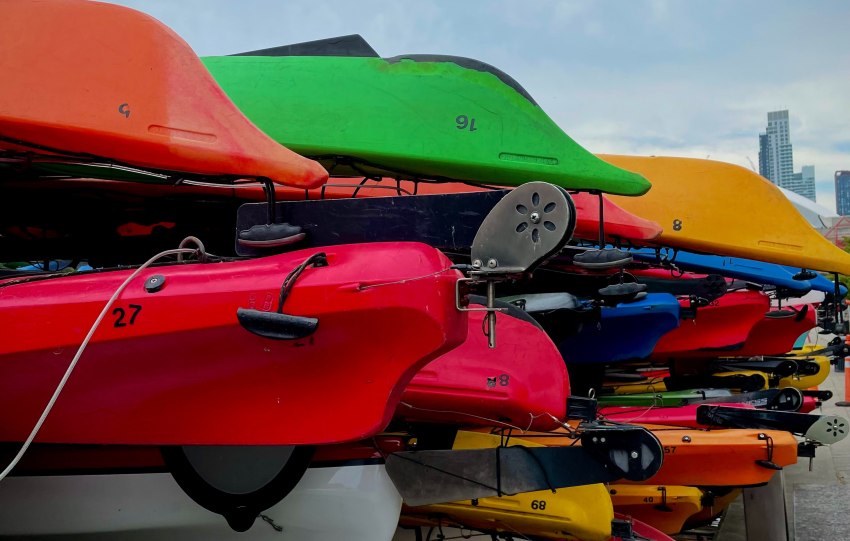
Yes, there absolutely is a best time of year for buying used kayaks!
Think about it: prices are governed by the law of supply and demand. When demand is high and supply is low, prices rise. When supply is high and demand is low, prices drop. You definitely want to shop for kayaks at the time of year when many used kayaks are for sale and not many people are looking to buy.
Which, of course, means late autumn and winter! (With, perhaps, the addition of early spring, depending on how cold your area is.)
During the late autumn months, people will likely be finishing up paddling season and preparing to store their kayaks for the winter. Maybe they’re deciding they’ve gotten all the use they want out of their kayaks, or they’ve bought a new kayak for their summer paddling. Whatever the case, it’s common for kayakers to sell off older, outdated, and used gear in autumn because it’s easier to sell their gear than try to store it.
During the winter, people often get tired of large, cumbersome kayaks cluttering up their garage or shed, and they decide to get rid of them.
Come spring, many kayakers are gearing up for the paddling season, looking for newer, better gear and getting rid of their old gear.
This is “peak buying season” for anyone going used kayak-shopping. Between late autumn and early spring, you can find kayaks sold at a steep discount because sellers just want to get their used kayaks out of their homes, and will often drop prices significantly because there is very little demand for kayaks during the “off-season”.
Keep your eye on the many places to buy used kayaks (as you’ll see below) to spot those once-in-a-lifetime deals we all hear about.
Note: Given that there’s a best time of year for kayak shopping, it stands to reason there’s also a worst time. And that time is during the late spring and early summer months when everyone is trying to buy kayaks in anticipation of the paddling months. You’re not only unlikely to find good deals, but you may end up spending MORE on a used kayak because of the high demand and limited supply.
Where to Buy Used Kayaks
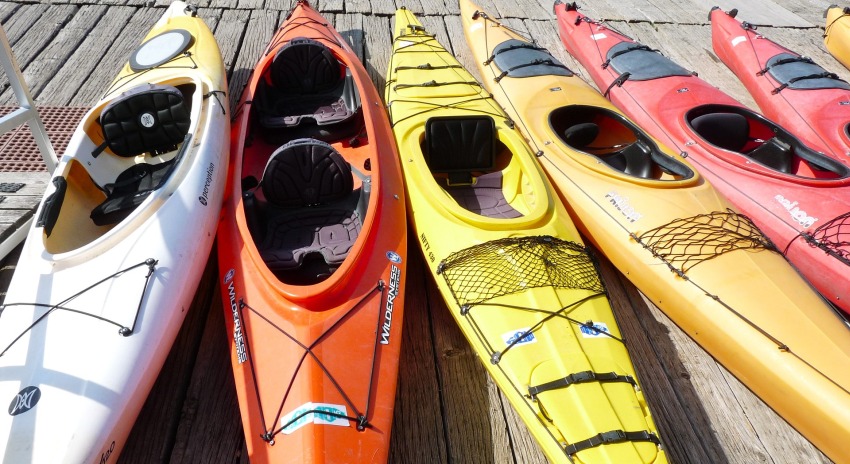
Not sure where to start looking for used kayaks? There are a few places to look where you’re all but guaranteed to find at least a few good options!
Facebook Marketplace
Facebook Marketplace is one of my favorite places to buy anything used. Not only is the messaging platform one I use daily (Messenger), but thanks to Facebook’s platform, you have access to a full range of photos and details for the items posted for sale.
All you have to do is set Marketplace to your city, decide the search radius (i.e. within 14 miles from your city, 150 miles from your city, etc.), and input the keyword “kayak”. You’ll get a full list of matches, and contacting the buyers is as easy as hit “Message” or even use Facebook’s existing message options. From there, you can set up a time and place to meet and see the kayak. Easy as pie!
Online Classified Ads
Sites like Craigslist and Kijiji (for us Canadians) have become a common place for online shopping and searching for used items. A lot of old-school users won’t be familiar with Marketplace, but they’ve been selling their used stuff on these classified ads websites for years. Thus, they’re more likely to post their used kayaks for sale on these sites and avoid Marketplace altogether.
Thanks to the integrated messaging service offered by these online classified ads sites, you can easily contact people to set up the time/date to see/test out/pick up the kayak.
eBay
eBay is another great place to check out for used kayaks. Typically, you’ll find lightly used (aka, nearly brand new) kayaks, which will usually only be sold marginally cheaper than the full-priced brand-new kayaks. However, some eBay sellers will offer used kayaks at a discount.
The downside of shopping for used kayaks on eBay is that you can’t see them in person, but you simply have to trust that a seller’s high rating (as ranked by previous customers) and the kayak’s descriptions and pictures posted are accurate enough that the kayak you receive is of the quality claimed.
Kayaking Forums
Kayaking forums are a great place to look for used kayaks! Paddlers tend to be a tight-knit band of like-minded adventures, and they’re often more than happy to help newbies and first-timers out. Posting on one of these forums that you’re looking for a used kayak is a great idea. Your fellow forum users may be able to connect you with kayak owners who are looking to sale (friends or other forum members) or offer you advice on where to go looking for good kayaks at a discounted price.
A few good forums and online communities to search include:
Garage Sales
I love garage sales! You can often find amazing treasures being sold at a steeply reduced price by people who just want to clear space and get rid of stuff they’re no longer using.
The beauty of garage sales is that you can see the kayak in person, and you can ask how well the owners have taken care of it. Typically, the kayak will be priced a bit lower (along with the rest of the discounted items) and the owners will be highly motivated the sell.
The downside, though, is that kayaks are among the items that tend to be ultra-popular (including tools, electronics, and other sporting goods). Unless you’re one of the first people to show up, chances are the kayaks will be gone fairly quickly. If you’re kayak-hunting, it’s a good idea to arrive at the garage sale as soon as it begins—especially if you know from public/online postings that there will be a kayak included among the items for sale.
Paddling and Boating Clubs
Boating clubs, kayaking clubs, racing clubs, canoeing clubs, and watersports clubs: all of these are great places to check out if you’re looking for used kayaks.
Typically, paddling clubs will use their kayaks for a few years, then upgrade to a newer model once their older models start wearing out or are no longer available. Because their aim is to provide the latest and best for their club members, they will likely upgrade far more often than the average paddler—at least 1-2 kayaks per year. If they can sell those kayaks at a decent price, all the better.
It’s worth checking in with your local clubs and organizations to see if they have any used kayaks they’re thinking of selling. Even if they don’t, they can be a great resource to point you in the direction of somewhere else you can find good deals on used kayaks.
Swap Meets/Flea Markets
Swap meets and flea markets can be large and daunting, but if you’re willing to invest the time in walking around, you can often find pretty sweet deals—including, with luck, a good deal on a used kayak.
Once again, kayaks are typically popular items that sell quickly, so you’ll want to be among the first to show up in the morning when the flea market/swap meet is just opening. There’s no guarantee there will be a used kayak for sale, but it’s worth an hour or two of your time to search the market.
Bonus points if you can find swap meets and flea markets specifically focused on water sports equipment!
Retailers
Sporting good retailers are another excellent place to search for used kayaks. They tend to stock only the latest-model kayaks, the ones they believe have the best chance of selling brand-new (for full price). When they want to get rid of older, no-longer-available, or unlikely-to-sell models, they may offer them at a steeply discounted price. They’ll also possibly do the same with the floor models and test models.
It’s a good idea to go to your local retailers and ask about outdated models or steep discounts. You may be able to find what time of year they do a “clear-out” sale to get rid of the items they can no longer sell, along with their demo and show kayaks. You may be able to find a sweet deal on a kayak in nearly-new condition because the retailer wants to get it off their showroom floor to make space for more inventory.
Another great place to look: retailers that specialize in used sporting goods rather than selling brand new. Pretty much every city has some sort of used sports goods retailer, which is often stocked by goods sold to them (at a discount) by retailers clearing out old and used inventory. Some also take used goods on consignment so they are essentially a storefront selling a lot of individuals’ products. These are an excellent place to find great deals on gear in great condition.
Water Sports Festivals
When cities host water sports festivals, they often offer kayaking rides or tours for those participating in the festivals. Once the celebrations are done, however, they may want to get rid of the kayaks rather than store them for a whole year until the next festival. That makes them a great place to ask about used kayaks.
Find the festival organizers (you should be able to track down staff via the information booth) and ask them about what is planned for the kayaks once the festival ends. There’s a decent chance they’ll be willing to talk re-selling if they have no intention of keeping them.
Thrift Stores
This is a bit of a long-shot, but always worth checking out! Every city has at least a few thrift stores, be it the Salvation Army, the Red, White, and Blue Thrift store, or some local thrift store operated by a charity or organization specific to your area. Because they’re receiving a fairly constant stream of donations, there’s a chance that someone will donate a kayak (and other sporting gear).
On the downside, thrifting is incredibly popular, meaning a fairly high number of customers every day. Chances are, any kayak that hits the shelves or is put on display will be snatched up within a matter of minutes. If you’re not the lucky one to spot it first, you may walk away empty-handed.
Still, it’s worth visiting thrift shops regularly on the off-chance there is a kayak for sale. A short stroll around the sporting goods and big ticket items sections should take no more than 5 minutes, and it’s well worth the time invested if it means you luck out and find a donated kayak for sale.
Pawn Shops
Pawn shops don’t often take kayaks, mainly because they’re large and hard to store/stock/put on display. However, if you live in a city where water sports are popular, there’s a chance that some of the larger or more popular pawn shops will accept kayaks. It’s worth checking them out every few weeks during the off-season in case a kayak goes up for sale.
How Much Should I Pay for a Used Kayak?

I want to make one thing clear: there is no hard-and-fast rule to follow when it comes to pricing used kayaks. It’s not that buying X kayak that is X number of years old will get you X% discount.
As with all sales of used equipment, the prices are very much set by the sellers and will reflect what they expect their kayak is likely to sell for based on other similarly priced items sold around the same time.
That being said, there are some general guidelines you can follow in order to make sure you’re getting a fair price (or, even better, a steal price!) on your used kayak.
Kayaks, like all vehicles and vessels, depreciate with every year and season of use. The older a kayak is, the more it is likely to depreciate. The harder and more often it’s used, the more its depreciation.
Knowing a kayak’s age and condition will help you to determine how fair the asking price is.
For a kayak in good condition that’s a few years old (3-7 years), you can expect to pay between 50 and 75% of the retail price in your local stores.
For example: Every year in British Columbia, Costco, Walmart, and Canadian Tire sell their base-model Pelican kayaks for around $400. When those kayaks eventually get sold used within a few years, they’ll be offered at $250 to $300.
Of course, this isn’t always the case. Some kayaks handle the years and seasons of use better than others, so they remain in excellent condition even as they age. These can be (and often are) re-sold for 70 to 90% of their original price. If a kayak is nearly new (1-2 years old), sellers will usually price them in the same 70-90% range.
And remember the law of supply and demand I mentioned above. If you’re trying to buy a used kayak at the same time of year that everyone else in your area is, sellers will see the high demand and raise their prices to make more off the kayak’s sale. Because people are so desperate to get their hands on a kayak during the warmer paddling months, they’ll be willing to pay much higher used prices.
Even worse, if stores sell out of kayaks (like they did during the 2020 summer months), private sellers of used kayaks can raise their prices significantly (higher even than brand new kayaks) because of the high demand and non-existent supply.
This is why it’s a good idea to go kayak-shopping during the off-season!
How to Inspect a Pre-Owned Kayak
When buying a kayak brand new, you can trust that the product is backed by a warranty and entirely damage-free. Not so with used kayaks. There’s no way you can know how a kayak has been handled or what sort of damage or deterioration it’s suffered. The only thing you can do is inspect the kayak for a visual assessment of its condition.
It’s no exaggeration to say that your inspection is the MOST important part of the used kayak-buying process. You may not be able to take it out for a test (see the next section), but a thorough inspection of every component and compartment will give you as clear an idea as possible of the kayak’s condition.
Here is your step-by-step guide to inspecting a used kayak before buying:
Step #1: Start with the Hull
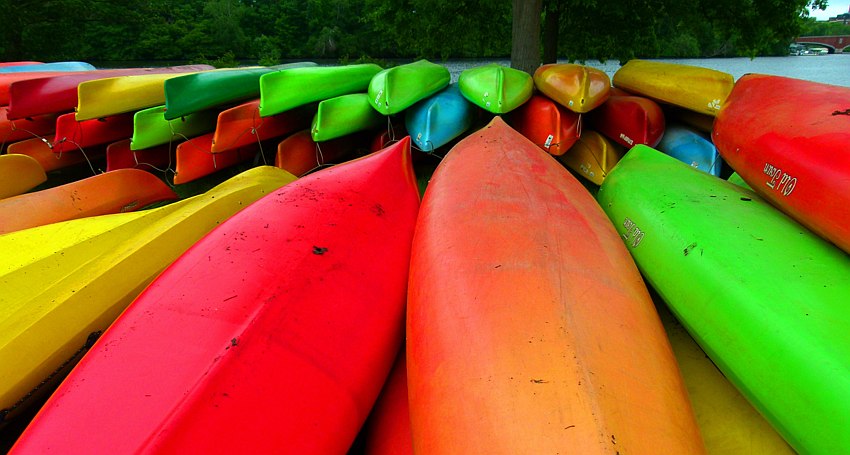
The hull is the part of the kayak most likely to sustain damage from exterior sources: underwater obstacles, fallen logs, the shore, other boats, etc. It’s also more prone to deteriorating due to long exposure to the sunlight (UV radiation degrades plastic).
Make sure to give the full hull a thorough inspection.
Start off with the top deck and look for any signs of discoloration or fading (common signs of UV damage), as well as any deformations in the deck. Minor scratches are no big deal, but any deep gouges, dents, or cracks are a warning sign.
Once you’re done with the top, check out the hull itself, again looking for any signs of damage (cracks, gouges, deep scratches, deformation/warping, etc.). Pay attention to the material of the kayak, too. If the walls look very thin and worn down, chances are it could spring a leak or easily crack with further wear or direct impact.
This is where you want to pay close attention to spot any signs the kayak has been repaired. One repair is pretty normal for older kayaks that have been hard-used (such as whitewater kayaks), but multiple repairs are a sign that A) the kayak is deteriorating and/or the hull is weakened, or B) the previous owner used it very hard and didn’t take proper care of it.
Step #2: Inspect the Compartments and Bulkheads
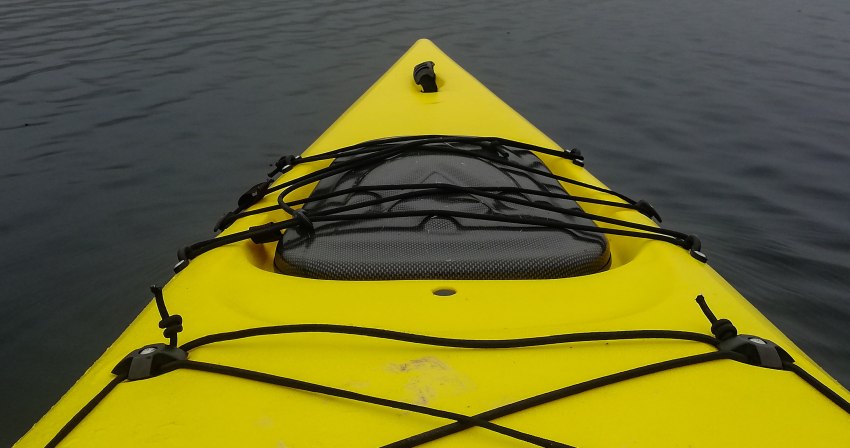
Once you’ve made sure the kayak’s body itself is sturdy, it’s time to move on to the other important structural components: the bulkheads and storage compartments.
Some may be built to be watertight, others open, and your inspection will vary according to the kayak model and design. What you want to look for is any sign of leakage, any cracks or holes that would allow water into the compartments.
Take a minute to look at the hatches, too. The hatch covers should open and close properly to create a water-tight seal on the top deck. Hatch covers can be easily replaced when worn out (the rubber tends to deteriorate with time and use), but if the hatches themselves are deformed, cracked, or damaged, it’s probably best to walk away.
Step #3: Check Out the Hardware and Fittings
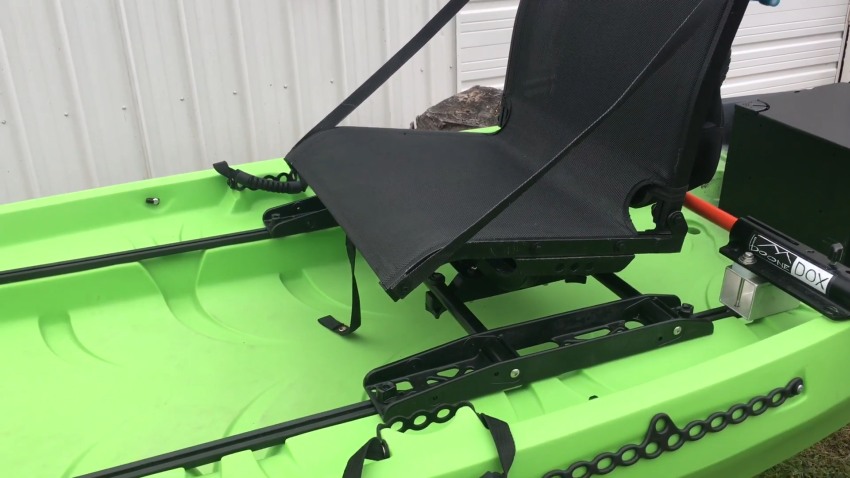
Now we need to look more closely at the hardware and fittings that keep the kayak functional. This includes:
- Scupper holes
- Hardware for racks and rails
- Fishing rod holders
- Bolts, screws, and mounting points
- Bungee rigging and tie-downs
- Pedal drive systems
- Handles
Make sure all of these are in good shape—or, at the very least, easily repaired. It’s normal for hardware and fittings to deteriorate over time and use, and they won’t always last as long as the sturdier hull. As long as you’re certain you can fix the issue (or afford to pay for the fix), it may still be worth buying the kayak.
Step #4: Analyze the Rudder and/or Skegs
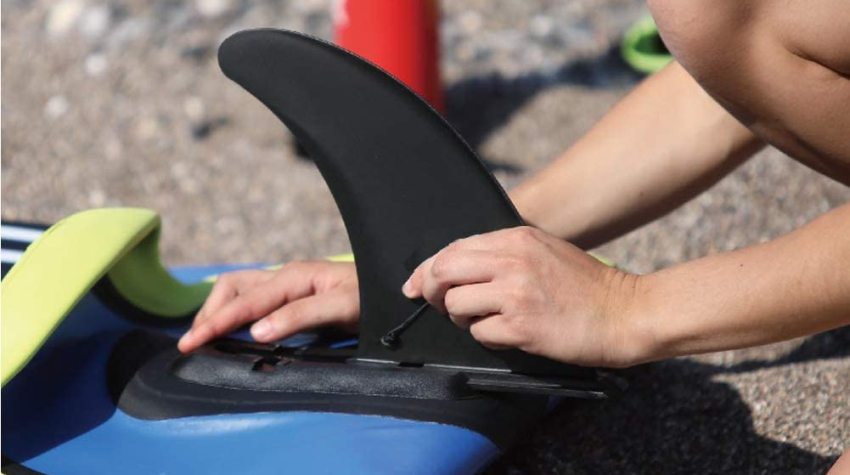
One last external component to inspect: the rudder and/or skegs.
Many kayaks (especially low-budget recreational kayaks) won’t have either rudder or skegs mounted, but the more advanced/pricier the kayak, the more complex the steering/tracking system.
Skegs are simple plastic fins mounted to the bottom, and they can be either fixed or removable. They are prone to deteriorate with prolonged exposure to saltwater as well as hard use (grinding them against rocky shores or river bottoms). Thankfully, they’re a fairly inexpensive component that can be easily replaced.
Rudders are a different story, however. Rudder systems tend to be more complex, often mounted to pedals or handles in the cockpit. If these systems are degraded or deteriorating, they may no longer be functional. Replacing them can be pricey and the kayak just won’t handle as well without them.
There are a number of DIY fixes that can help you salvage a damaged kayak rudder system, and you can always use the damage to bargain the price down a bit lower (making it worth your investment to pay for a new rudder system). It’s a factor to take into consideration when making your decision whether or not to buy.
Step #5: Test the Cockpit
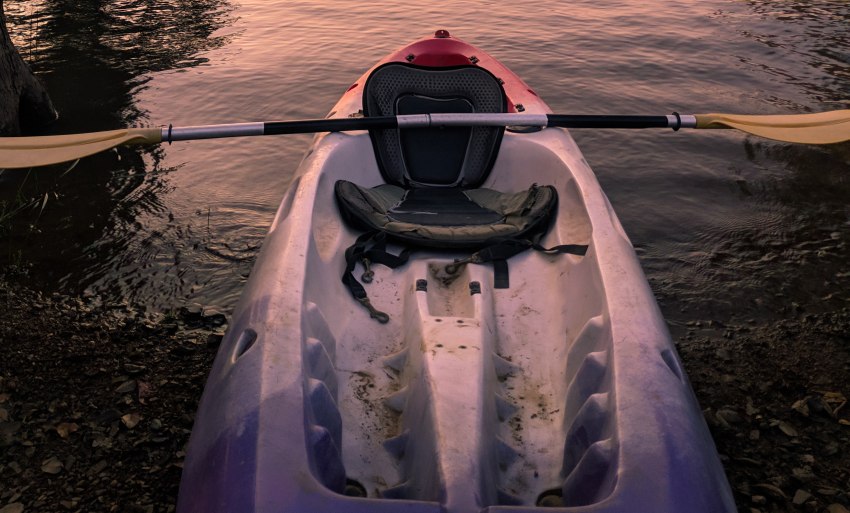
Last but not least, you need to test the cockpit—a.k.a. the place where you will be spending all of your long hours sitting and paddling.
It goes without saying that discomfort is not ideal when kayaking. A kayak cockpit that is too small for your frame can actually be dangerous (you can’t bail out in case of capsize), and may lead to common problems like dead legs, cramps, or aching joints.
To begin, make sure the size actually fits your frame. Ask to sit in the kayak (on the ground), and test to ensure you can enter and exit the cockpit easily. Pay attention to the cockpit coaming to make sure it isn’t warped, cracked, or bent.
Once inside the cockpit, extend your legs fully so you know it can handle your unique leg length. Brace your feet against the foot pads and press your thighs against the thigh pads. Test to make sure both are in proper working condition and provide sufficient bracing for your paddling.
Pay attention to how the seat feels, too. Entry-level kayaks tend to have simple, often-uncomfortable seats integrated into the frame, with only minimal padding and support. Higher-end kayaks will have better-quality, more ergonomic seats with better support, a design that promotes better circulation, and will keep you comfortable for long hours of paddling.
Make sure the seat’s straps, cinches, buckles, and hardware are all in good condition, too. Get out of the kayak and adjust the seat and foot pedals by hand. Everything should slide/adjust smoothly. If there is rust, fraying, cracks, loose screws, or visible damage to the interior components, you may end up replacing them (which can raise the price of the kayak more than you’d expect!).
With this visual inspection, you can do your utmost to ensure the kayak is in the best possible condition—and, in the long run, worth the investment.
Whenever Possible, Take it for a Test Paddle
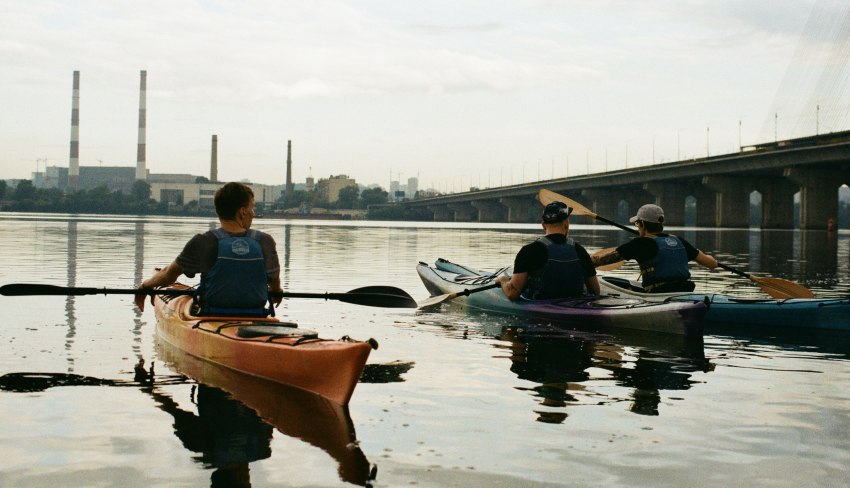
There’s nothing like a real-life paddling test to let you know how well a kayak handles.
Let’s be clear: private sellers may not allow you to take the kayak out for a test paddle, especially if you’re buying the kayak from their home. You’ll have to rely entirely on the visual inspection to ensure it’s in good shape before you drive off with it. (And, if you’re buying during the off-season when it’s too cold to paddle, you can’t exactly take it for a test.)
However, it’s worth asking the seller if they’ll offer a “guarantee” of sorts, that they’ll refund your money is the kayak is defective or damaged. They may say no—and there’s nothing to compel them to agree—but upstanding citizens will often stand by the quality of the item they’re selling enough to agree to your request. That way, you can take the kayak for a test run to make sure it’s not leaking, damaged, or breaking.
On the other hand, if you’re buying from a paddling club or a brick-and-mortar retailer, they should be willing to let you take the kayak out for a test paddle. Even if it’s just a short jaunt around a local lake or river, they have a reputation to maintain, so they’re often willing to accommodate your request in order to make the sale.
Testing your kayak will help you to see how it handles in real-life conditions, whether it steers and tracks straight, whether there’s any serious damage, how comfortable it is, and how well it suits your needs. You’ll get a clearer picture of just how well it will work for you, and it’ll be the deciding factor on whether you buy it or keep looking.
Closing Thoughts
Well, there you have it! A complete guide to buying used kayaks, with all the information you need to know about how to make the right choice.
Buying a used kayak doesn’t have to be a headache or stressor, but you may find that it’s actually quite an enjoyable process if you approach it the right way. You can meet fellow kayakers, exchange paddling stories, get insights into cool places to paddle, and, best of all, walk away with an awesome used kayak at a price you’re willing to pay.
It’s a win-win for everyone involved!



